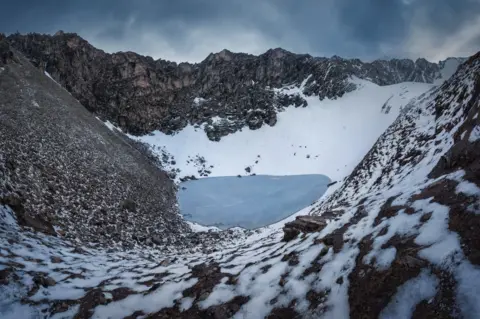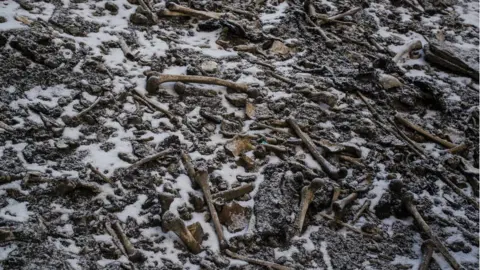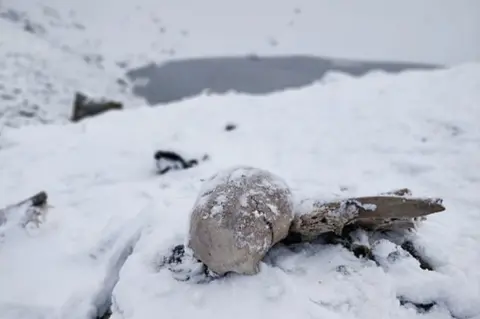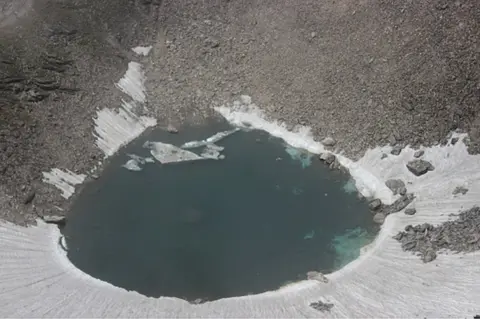The mystery of India’s ‘lake of skeletons’

 Atish Waghwase
Atish WaghwaseHigh in the Indian Himalayas, a remote lake nestled in a snowy valley is strewn with hundreds of human skeletons.
Roopkund Lake is located 5,029 metres (16,500ft) above sea level at the bottom of a steep slope on Trisul, one of India's highest mountains, in the state of Uttarakhand.
The remains are strewn around and beneath the ice at the "lake of skeletons", discovered by a patrolling British forest ranger in 1942.
Depending on the season and weather, the lake, which remains frozen for most of the year, expands and shrinks. Only when the snow melts are the skeletons visible, sometimes with flesh attached and well preserved. To date, the skeletal remains of an estimated 600-800 people have been found here. In tourism promotions, the local government describes it as a "mystery lake".
For more than half-a-century anthropologists and scientists have studied the remains and puzzled over a host of questions.
Who were these people? When did they die? How did they die? Where did they come from?
One old theory associates the remains to an Indian king, his wife and their attendants, all of whom perished in a blizzard some 870 years ago.
 Himadri Sinha Roy
Himadri Sinha RoyAnother suggests that some of the remains are of Indian soldiers who tried to invade Tibet in 1841, and were beaten back. More than 70 of them were then forced to find their way home over the Himalayas and died on the way.
Yet another assumes that this could have been a "cemetery" where victims of an epidemic were buried. In villages in the area, there's a popular folk song that talks about how Goddess Nanda Devi created a hail storm "as hard as iron" which killed people winding their way past the lake. India's second-highest mountain, Nanda Devi, is revered as a goddess.
Earlier studies of skeletons have found that most of the people who died were tall - "more than average stature". Most of them were middle-aged adults, aged between 35 and 40. There were no babies or children. Some of them were elderly women. All were of reasonably good health.
Also, it was generally assumed that the skeletons were of a single group of people who died all at once in a single catastrophic incident during the 9th Century.
The latest five-year-long study, involving 28 co-authors from 16 institutions based in India, US and Germany, found all these assumptions may not be true.
Scientists genetically analysed and carbon-dated the remains of 38 bodies, including 15 women, found at the lake - some of them date back to around 1,200 years.
 Getty Images
Getty ImagesThey found that the dead were both genetically diverse and their deaths were separated in time by as much as 1,000 years.
"It upends any explanations that involved a single catastrophic event that lead to their deaths," Eadaoin Harney, the lead author of the study, and a doctoral student at Harvard University, told me. "It is still not clear what happened at Roopkund Lake, but we can now be certain that the deaths of these individuals cannot be explained by a single event."
But more interestingly, the genetics study found the dead comprised a diverse people: one group of people had genetics similar to present-day people who live in South Asia, while the other "closely related" to people living in present-day Europe, particularly those living in the Greek island of Crete.
Also, the people who came from South Asia "do not appear to come from the same population".
"Some of them have ancestry that would be more common in groups from the north of the subcontinent, while others have ancestry that would be more common from more southern groups," says Ms Harney.
So did these diverse groups of people travel to the lake in smaller batches over a period of a few hundred years? Did some of them die during a single event?
No arms or weapons or trade goods were found at the site - the lake is not located on a trade route. Genetic studies found no evidence of the presence of any ancient bacterial pathogen that could provide disease as an explanation for the cause of deaths.
 Getty Images
Getty ImagesA pilgrimage that passes by the lake might explain why people were travelling in the area. Studies reveal that credible accounts of pilgrimage in the area do not appear until the late 19th Century, but inscriptions in local temples date between 8th and 10th Centuries, "suggesting potential earlier origins".
So scientists believe that some of the bodies found at the site happened because of a "mass death during a pilgrimage event".
But how did people from the eastern Mediterranean land up at a remote lake in India's highest mountains?
It seems unlikely that people from Europe would have travelled all the way from Roopkund to participate in a Hindu pilgrimage.
Or was it a genetically isolated population of people from distant eastern Mediterranean ancestry that had been living in the region for many generations?
"We are still searching for answers," says Ms Harney.

You may also be interested in...

